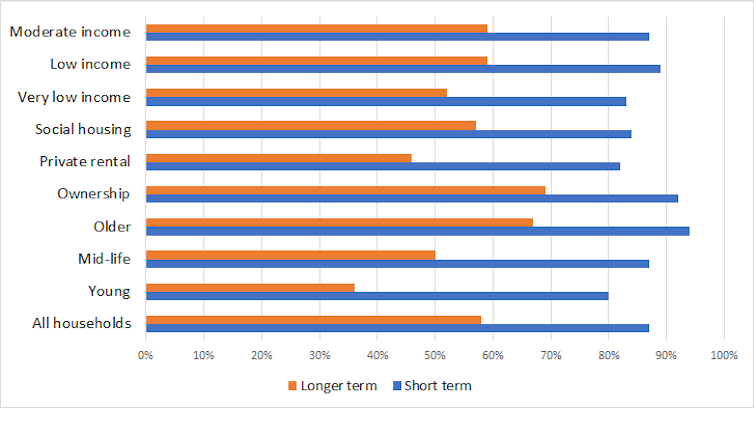Source: The Conversation (Au and NZ) – By Wendy Stone, Associate Professor, Centre for Urban Transitions and Director, Australian Housing and Urban Research Institute Swinburne Research Centre, Swinburne University of Technology
New research released today asked Australians how well current housing met their needs and their ideals, both in the short and longer-term.
We found safety and security was the main aspiration of householders across age groups. Given the turbulent year for many households, we wished to explore how the pandemic might change what people want from their homes.
What do people want from a home?
We surveyed more than 7,400 Australians in young, mid-life and older households, including Indigenous, non-Indigenous and widely diverse Australians, online or in interviews.
We asked what they want from housing, and the constraints that mean they haven’t been able to get there.
We found “safety and security” were fundamental to the housing aspirations of young, mid- and later life Australians. Some 75% of respondents indicated these basic characteristics were the key housing attributes they value. For a majority of Australians, these attributes were associated with home ownership.The figure below shows four in five Australians are satisfied with their current housing in the short term, but when they consider their longer term needs these levels of satisfaction drop considerably. This is particularly so among renters, linked to a lack of security in the tenure.

The survey asked participants to choose their ideal housing in terms of location, tenure, dwelling type and number of bedrooms. The results showed there was a preference for owning a house with three or more bedrooms within the suburbs of capital cities, with a notable number also showing a preference for regional living.
But not all households believe they can attain this ideal with rising inequality also fuelling the housing aspirations gap. When we asked households what they need to achieve their ideal housing, results show targeted support is critical — such as assistance with up-front deposits, fees or bonds, and support to manage ongoing housing costs in the context of disruptions such as COVID.
What about post-COVID?
If anything, the pandemic has reinforced trends in housing aspirations.
First, housing security matters. The disruptions of 2020 have highlighted housing insecurity, particularly among those with precarious incomes. Government interventions including JobKeeper, JobSeeker, evictions moratoria and schemes such as the Victorian Rental Relief Grant have been necessary to keep renters in their homes, with banks having deferred mortgage payments for tens of thousands of additional households.
Read more: 400,000 women over 45 are at risk of homelessness in Australia
Second, walkable neighbourhoods are the way of the future. COVID-19 reaffirms the importance of local neighbourhoods as amenity centres. This includes local areas that include green space, local produce and a sense of community. Our findings show suburban living and regional towns are attractive options for households across all ages, including younger adults.
Third, adaptable living is key. Home has never been as important as a hub of both productivity and care. Working from home and online education have become the norm for many households in Australia and globally. This requires adequate space, quality digital connectivity and adaptable living areas that can accommodate the whole family and different activities.
Young adults have needed to relocate quickly in some cases, with households at mid-life finding themselves potentially housing both young adult children (and maybe grandchildren) as well as elderly parents. As fears rise about the safety of existing aged care residences, housing that supports home-based elder care also becomes critical.
Creating a better housing future
Our research shows safety and security is key to what people want from housing, so reducing entry costs to home ownership and delivering rent-buy models (that enable people to transition from renting to buying) are important policy directions.
Improving housing knowledge and housing market skills to enable households to explore options, make more informed housing decisions and plan for their housing futures are also key elements. Creating optimal housing requires collaborating with residents as experts, on what they value.
Read more: ‘Uprooting, no matter how small a plant you are, is a trauma’: older women renters are struggling
– ref. How might COVID-19 change what Australians want from their homes? – https://theconversation.com/how-might-covid-19-change-what-australians-want-from-their-homes-145626








